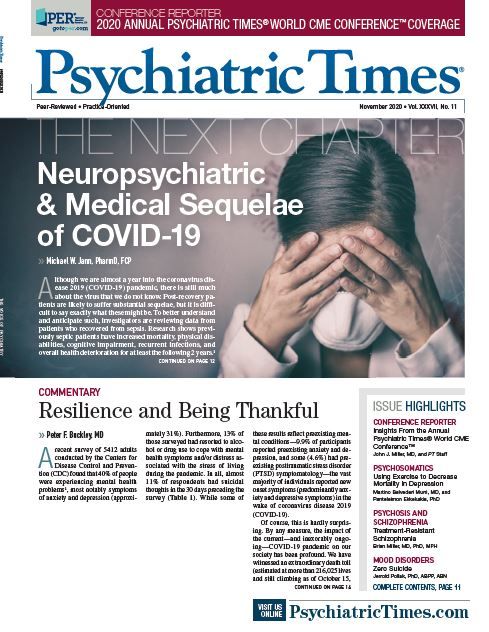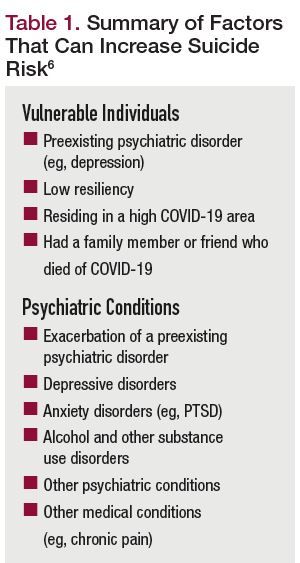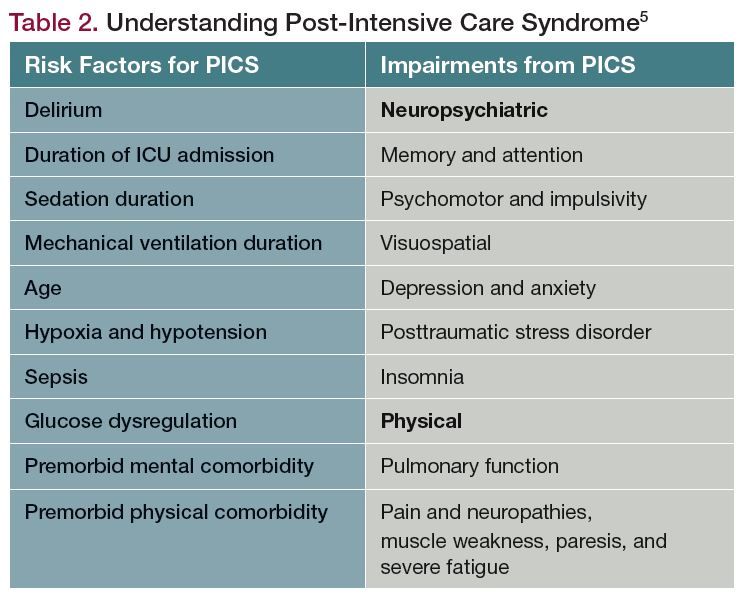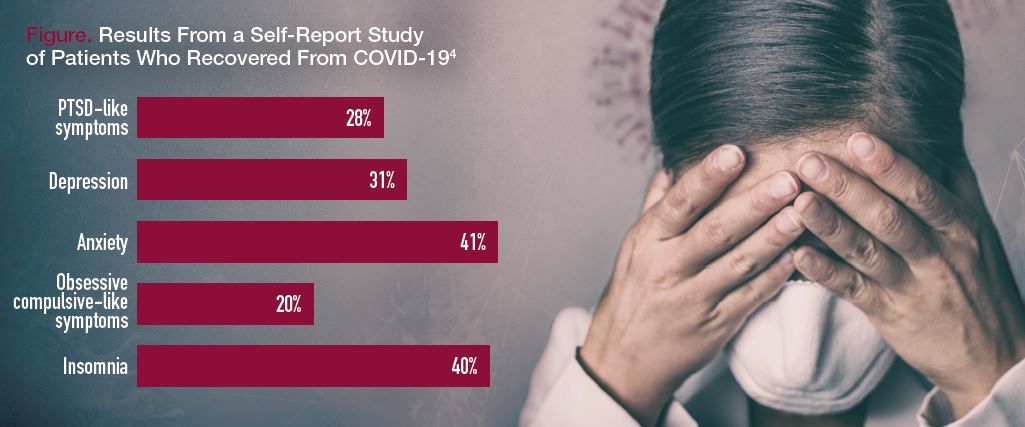Neuropsychiatric & Medical Sequelae of COVID-19
Learning from past disasters, psychiatrists are taking center staet in helping patients, family members, first responders, and other health care professionals affected by the COVID-19 pandemic.
maridav/AdobeStock
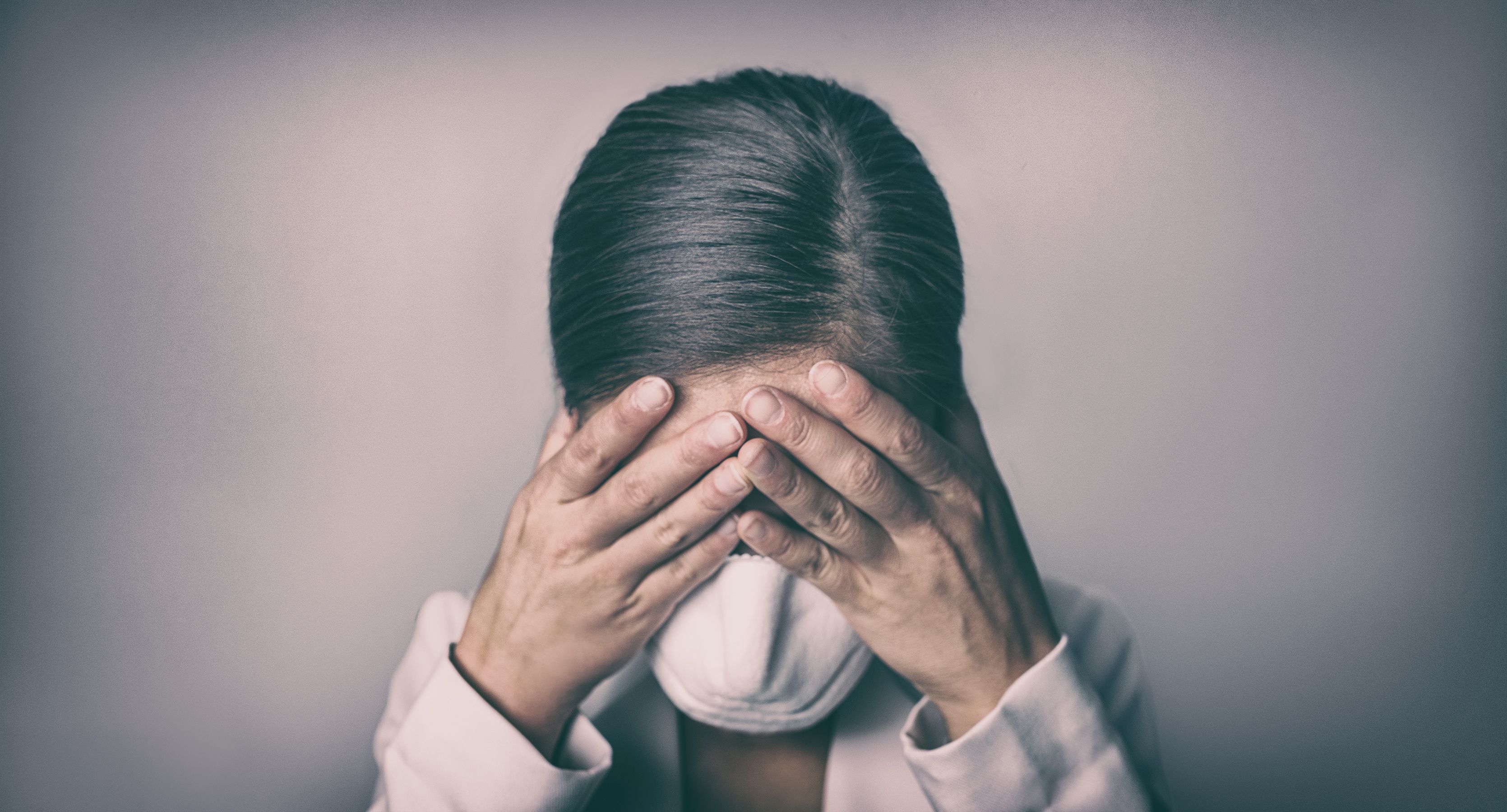
THE NEXT CHAPTER
Although we are almost a year into the coronavirus disease 2019 (COVID-19) pandemic, there is still much about the virus that we do not know. Post-recovery patients are likely to suffer substantial sequelae, but it is difficult to say exactly what these might be. To better understand and anticipate such, investigators are reviewing data from patients who recovered from sepsis. Research shows previously septic patients have increased mortality, physical disabilities, cognitive impairment, recurrent infections, and overall health deterioration for at least the following 2 years.1 The pandemic's impact will likely trigger enormous aftershocks in recovery and rehabilitation services. Anticipating possible scenarios now will help psychiatrists and other medical professionals prepare for effective treatment later.2
Post–COVID-19 neuropsychiatric sequelae
Patients who recover from acute COVID-19 can experience a variety of neuropsychiatric manifestations.3,4 For individuals with mild to moderate infections, the most common symptoms include headache, altered smell and taste, cough, asthenia, and myalgia. Regarding smell and taste, these dysfunctions occurred at rates of 85% and 88%, respectively. When severe illness occurs, reports of encephalopathies, encephalitis, seizures, neuromuscular disorders, Guillain-Barré syndrome, and other neuropathies were reported in about 36% of patients.
In a study of patients who were admitted to the intensive care unit (ICU), researchers found a number of long-term effects.1 Patients in the ICU with acute respiratory distress syndrome (ARDS) and severe illness (91% on ventilation) had average global cognition scores 1.5 standard deviations (SD) below the age-adjusted mean population and were similar to patients with mild cognitive impairment. Of those patients, 26% had 2 SD below the normal. Patients with mild Alzheimer disease and repeated testing at 12 months later did not show significant improvement. Cognitive impairment was noted in 70% to 100% of discharged patients, 46% to 80% had impairment 1 year and even 5 years later, and 20% had residual cognitive dysfunction.1 If patients admitted to the ICU with COVID-19 follow these trends, they will feel the virus’ effects for years to come.
Patients who have recovered from COVID-19 experience a wide range of psychiatric issues, including posttraumatic stress disorder (PTSD), depression, insomnia, anxiety, and suicide.4 If we use data from patients with ARDS with ICU admissions as a predictive model, the incidence of psychiatric sequelae was found to be 22% to 24% for PTSD, 26% to 33% for depression, and 38% to 44% for generalized anxiety.1 A significant risk factor for these patients was the presence of premorbid psychiatric illnesses. Family members also can experience PTSD, depression, and anxiety while adjusting to their new roles as caregivers.
A recent study of patients who had COVID-19 (N=402) noted 55.7% had at least 1 psychiatric-related condition with the symptoms found in the Figure (these data are from self-reported questionnaires so we cannot assume these are actual DSM-5 diagnoses).4 A variety of inflammatory laboratory biomarkers (eg, C-reactive protein) results were obtained from the patient charts to determine any possible links with the psychiatric illnesses. Oxygen saturation levels and inflammatory biomarkers were found not to be associated with any of the psychiatric symptoms, suggesting that the mental health consequences may not have been a manifestation of physical symptoms (ie, virus effects on the brain).
It was reported that 0.9% to 4% of patients who had COVID-19 developed psychotic spectrum disorders, with appropriate antipsychotic treatment indicated.3 Psychotropic medications should be continued (where possible) or restarted in patients with preexisting psychiatric conditions. Medication selection should be based upon the existing guidelines associated with the various psychiatric illnesses. Finally, alcohol and substance use disorders can emerge or be exacerbated in post–COVID-19 recovery, hence clinicians should monitor patients and their families for these.
Because of the acute and chronic stress conditions that accompany the mental health consequences for survivors and their families, the psychological sequelae may persist for months or years. Individuals who had COVID-19, and especially those who had severe COVID-19 illness, are at an increased risk of suicide.6 The suicide rate in the United States has been steadily increasing from 1999 to 20177, and the COVID-19 pandemic adds a suicide risk factor that providers need to monitor. Factors that increase suicide risk in context of COVID-19 include economic problems, social isolation, and uncertainty about the future, as shown in Table 1. Suicide assessment should be included in the short- and long-term treatment of survivors.
It is unknown whether COVID-19 can exacerbate or increase risk for other neuropsychiatric effects. A case report described a patient who was treated with haloperidol decanoate and 3 weeks after injection developed neuroleptic malignant syndrome. The patient recovered and was treated with dantrolene and bromocriptine.8 Another case report portrayed a previously healthy man in his 60s living with family members who had COVID-19.9 He became confused, slowed, and forgetful, and tested positive for the virus. During the next 2 weeks, his disorientation became much worse, and he was admitted to the hospital. He received a complete laboratory assessment in which the CSF RT-QuIC, 14-3-3, and T-tau protein results confirmed Creutzfeldt-Jakob disease (CJD). The patient died 2 months after the initial onset of symptoms, and it is not clear whether the COVID-19 infection accelerated the course of the CJD. As COVID-19 increases risk of neuropsychiatric sequelae, it is possible that other neurological consequences may emerge and providers should be vigilant.
Post-intensive care syndrome
Patients with COVID-19 and severe respiratory impairment must remain on mechanical ventilators for longer time periods than the typical ICU admission.5 Recovery from the ICU can lead to short- and long-term consequences that stem from the post-intensive care syndrome (PICS). A summary of the PICS risk factors and neuropsychiatric and physical impairments are presented in Table 2.5 During a prolonged stay in the ICU, sedation and mechanical ventilation increases the PICS risk. About 33% of patients recovering from PICS do not return to work and another 33% do not go back to their pre-ICU job or a job with a pre-ICU salary. At least 25% of these individuals have substantial loss of independent living and require assistance with daily activities for at least 1 year post-ICU admission.4
Complications that affect recovery from severe COVID-19 illness can be categorized into 2 other main areas: critical illness polyneuropathy (CIP) and critical illness myopathy (CIM).1,5 The CIP is a mixed sensorimotor neuropathy with an occurrence reported to be about 46% in ICU patients. It is associated with neuropsychiatric impairment, pain, muscle weakness, fatigue, dysphagia, and incontinence. CIM occurs in 48% to 96% of patients in the ICU and is a non-necrotizing diffuse myopathy with fatty degeneration, atrophy, and fibrosis. The CIM clinical presentation is similar to CIP but with more distal weakness and sensory preservation and may be associated with use of paralytic agents, steroids, and sepsis. Patients recover more completely and quickly from CIM than CIP. However, impaired function and quality of life from both conditions can linger for 2 years or longer.1 Based on the Medicare data from sepsis, about 50% of recovered patients will need additional facility-based care and home health care.2 Given the challenges from quarantine measures required by COVID-19, this presents additional issues that must be faced in the short- and long-term recovery programs.
Practical applications for managing symptoms
As patients recover and are discharged from hospitals, they face many challenges in the short- and long-term management of their mental and physical rehabilitation. Interdisciplinary team treatment approaches will be necessary. The medical sequelae from COVID-19 will determine initial short-term rehabilitation needs (eg, respiratory system) and its comorbidities (eg, hypertension, diabetes) and form the treatment plans. At discharge, clinicians should establish treatment plans that can be continued at another facility or with home health services. Mental health services should be an integral aspect of the patient’s overall treatment plan with continued assessments during physical rehabilitation. The presence of PTSD, depression, anxiety, or other psychiatric symptoms should be detected as early as possible with appropriate treatment programs incorporated for at least the first 2 years following infection.
Cognitive impairment may persist for years after recovery from COVID-19. Improving these symptoms will require a collaborative approach between family members and health care professionals. The stressful psychological impact of quarantine cannot be underestimated.10 Upon discharge from the hospital or facility, the survivor and their family members face fears of infection, reinfection, frustration, helplessness, boredom, and uncertainty about what the future holds. Historically, alonger period of quarantine duration was associated with worse mental health, specifically PTSD.10 Finally, financial stressors and the stigma of quarantine influence rates of acceptance and adherence. Once people accept that quarantine is necessary for public health reasons and not a political choice, then it becomes easier to endure psychologically.10
Access to physical and mental health care services for patients who have recovered from COVID-19 is a major concern. This is particularly true for minority populations, as COVID-19 infections disproportionally affect African-American and Latino patients.11 These 2 populations are 2 to 3 times more likely to know someone who died from COVID-19 than white individuals. Their recovery and rehabilitation should include culturally competent services along with technological support for internet, smart phones, or tablets necessary for telemedicine.
Concluding thoughts
The COVID-19 pandemic has revealed significant weaknesses in our health care system, from public health preparedness to the structure of our medical facilities and the need for long-term rehabilitation.12 A rational systematic approach to a pandemic with lessons learned from the past can provide guidance. Mental health services play a vital role in treating patients, family members, first responders, and health care professionals.13
The impact of COVID-19 will reverberate for many years. For example, PTSD, depression, anxiety, and other disorders remain among post-9/11 first responders and individuals in New York City nearly 20 years after the attacks.14 Identifying disaster-related stressors that predict physical and mental health adversity after natural disasters such as Hurricane Katrina can also be applied to the COVID-19 environment.15 One to 4 years post-Katrina, lack of medications, medical care, safety, and bereavement were the main stress predictors for PTSD, psychological distress, and physical symptoms. The belief that an individual’s life was in danger continued to predict PTSD at 12 years after the disaster.15
Both 9/11 and Hurricane Katrina were acutely short in duration, yet they had long-term health consequences. The COVID-19 pandemic began in late 2019 and will continue for the foreseeable future. Learning from past disasters, health care systems need to minimize any lapses in services for medical care, mental health care, and medications. Policy makers need to provide infrastructure support for the economic and technological sustenance of our society for years, as COVID-19 has changed our way of life. Psychiatrists and other mental health professionals should be prepared for the short-term (less than 2 years) and long-term (more than 2 years) management of patients and others affected by the pandemic. Psychiatry has faced unusual tasks during the COVID-19 pandemic, with increasing distress among our society that has led to increasing rates of depression, anxiety, and other mental health conditions. This trend will likely continue, and close collaboration between primary care providers and mental health professionals will be needed.16
Dr Jann is professor of pharmacotherapy at the University of North Texas System College of Pharmacy and founder of Jann Medical Writing.
References
1. Sheehy LM. Considerations for postacute rehabilitation for survivors of COVID-19. JMIR Public Health Surveill. 2020;6(2):e19462.
2. Grabowski DC, Joynt Maddox KE. Postacute care preparedness for COVID-19: Thinking ahead. JAMA. 2020; 323(20):2007-2008.
3. Dinakaran D, Manjunatha N, Naveen Kumar C, Suresh BM. Neuropsychiatric aspects of COVID-19 pandemic: a selective review. Asian J Psychiatry. 2020;53:102188.
4. Mazza MG, De Lorenzo R, Conte C, et al. Anxiety and depression in COVID-19 survivors: role of inflammatory and clinical predictors. Brain Behav Immun. 2020.89:594-600.
5. Stam HJ, Stucki G, Beckenbach J, et al. COVID-19 and post intensive care syndrome: a call for action. J Rehabil Med. 2020; 52: jrm00044.
6. Sher L. The impact of the COVID-19 pandemic on suicide rates. QJM. 2020 June15:hcaa202.
7. Hedegaard H, Curtin CC, Warner M. Suicide mortality in the United States, 1999-2017. NCHS Data Brief. 2018; 330:1-8.
8. Kajani R, Apramian A, Vega A, et al. Neuroleptic malignant syndrome in a COVID-19 patient. Brain Behav Immun. 2020; 88:28-29.
9. Young Mj, O’Hare M, Matiello M, Schmahmann JD. Creutzfeldt-Jakob disease in a man with COVID-19: SARS-CoV-2 accelerated neurodegeneration? Brain Behav Immun. 15:S0889-1591(20)31522-1.
10. Brooks SK, Webster RK, Smith LE, et al. The psychological impact of quarantine and how to reduce it: rapid review of the evidence. Lancet. 2020; 39: 912-920.
11. Johnson SF, Tiako MJN, Flash MJE, et al. Disparities in the recovery from critical illness due to COVID-19. Lancet Psychiatry. 2020; 7:e54-e55.
12. Tandon R. COVID-19 and mental health: preserving humanity, maintaining sanity, and promoting health. Asian J Psychiatry. 2020; 51:102256.
13. Pfefferbaum B, North CS. Mental health and the COVID-19 pandemic. NEJM. 2020; 383:510-512.
14. DePierro J, Lowe S, Katz C. Lessons learned from 9/11: mental health perspectives on the COVID-19. Psychiatry Res. 2020; 288:113024.
15. Raker EJ, Zacher M, Lowe SR. Lessons from Hurricane Katrina for predicting the indirect health consequences of the COVID-19 pandemic. PNAS. 2020; 117:12595-12597.
16. Öngür D, Perlis R, Goff D. Psychiatry and COVID-19. JAMA. 2020;324(12):1149-1150. ❒
